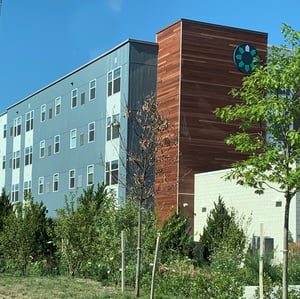 When people think of green buildings, they are so often focused on concepts such as energy savings, water savings, waste reduction and indoor air quality. But true sustainability encompasses so much more that just the environmental outcomes green buildings achieve. True sustainability also results in economies that improve health and well-being for the people and societies they serve.
When people think of green buildings, they are so often focused on concepts such as energy savings, water savings, waste reduction and indoor air quality. But true sustainability encompasses so much more that just the environmental outcomes green buildings achieve. True sustainability also results in economies that improve health and well-being for the people and societies they serve.
People. It is ultimately for the health and well-being of people that we care about the environment. Building projects present an opportunity to achieve true sustainable outcomes when social equity is a tenant of success. After all, people live, learn, work and play in buildings, and people are certainly involved in the design, construction and operation of buildings.
That is why green building rating systems, such as LEED, seek to promote social equity with the recent release of three pilot credits focused on Social Equity. Each pilot credit is worth one point and can be pursued as innovation credits. The social equity pilot credits also serve as a foundation and as guide-posts for projects not pursuing certifications, but that embrace the concepts of social equity and diversity and inclusion.
Pilot Credit: Social Equity within the Project Team
Intent: Encourage any and all members of the project team to promote and further social equity by integrating strategies that address identified social and economic needs and disparities among those working on the project by:
-
Creating more equitable, healthier, and more supportive environments for construction workers during project construction through:
- Ensuring fair and equitable pay and benefits for work performed
- Promoting employable skill development
- Promoting personal financial and health stability
-
Promoting corporate social responsibility at an organizational level by the firms of the project owner, financier, architects/engineers, contractors, product manufacturers, etc.
Pilot Credit: Social Equity within the Supply Chain
Intent: Encourage any and all members of the project team to promote and further social equity by integrating strategies that address identified social and community issues, needs and disparities among those affected by the project by:
-
Promoting fair trade, respect for human rights, and other equity practices among disadvantaged communities
-
Creating more equitable, healthier environments for those affected by manufacturing of the materials created for the project.
Pilot Credit: Social Equity within the Community
Intent: Encourage any and all members of the project team to promote and further social equity by integrating strategies that address identified social and community needs and disparities among those affected by the project by:
-
Creating fairer, healthier, and more supportive environment for those who work/live in the project
-
Responding to the needs of the surrounding community to promote a fair distribution of benefits and burdens
-
Promoting fair trade, respect for human rights, and other equity practices among disadvantaged communities.
The goal of the Social Equity within the Community pilot credit is to help projects address disparities in access and social inequities within a project’s own community. In order to go beyond charity to support meaningful transformation, building teams must begin to understand the various parts of their communities and understand how they are connected, and community members (particularly those who are vulnerable, disadvantaged and under-represented) must have a greater voice in decisions that impact them.
True Sustainability Embraces Social Equity
Social equity is a topic often battled at the grass-roots level by people and organizations without true buying power. Through the LEED Social Equity Pilot Credits, project owners are empowered to partner with local leaders and organizations to create programs and systems for workforce and vendor-supplier relationships. They help project owners design and execute strategies that stand to improve the economic health and well-being of people both during the project and after. These credits also can help support wrap-around services such as affordable housing and public health initiatives in communities that will truly benefit deeply from them. If you are interested in achieving these credits, or any other sustainability initiatives in your built environment, we can help.
Posts by Tag
- Sustainability (171)
- sustainability consulting (143)
- Energy Efficiency (126)
- Utilities (91)
- LEED (87)
- Sustainable Design (69)
- green building certification (59)
- energy audit (46)
- ESG (45)
- construction (43)
- GHG Emissions (36)
- WELL (32)
- carbon neutrality (31)
- net zero (27)
- tax incentives (27)
- costs (26)
- energy modeling (18)
- electric vehicles (17)
- Energy Star (14)
- Housing (14)
- Inflation Reduction Act (13)
- water efficiency (13)
- Social Equity (12)
- decarbonization (12)
- diversity (10)
- NGBS (7)
- fitwel (7)
- Earth Day (6)
- electrification (5)
- mass timber (5)
- non-profit (5)
- retro-commissioning (5)
- Emerald Gives (4)
- Engineering (4)
- News Releases (4)
- B Corp (3)
- COVID-19 Certification (3)
- Customers (3)
- Indoor Air Quality (3)
- PACE (3)
- Arc (2)
- DEI (2)
- EcoDistricts (2)
- EcoVadis (2)
- Green Globes (2)
- cannabis (2)
- CDP (1)
- SITES (1)
- furniture (1)
- opportunity zone (1)
- womenleaders (1)


